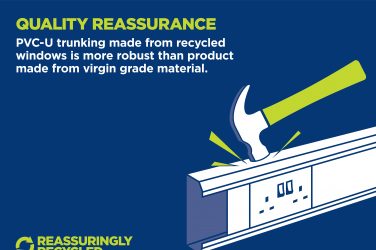Did you know lower performing halogens are expected to be banned by 2018? Now is the time to be switching to LED. Wayne Lysaght-Mason, managing director at ElectricalDirect.co.uk, discusses the benefits of LED for external lighting.
Last year EU regulations came into place to ensure that only lamps with an energy rating of B or better are now available to purchase, as part of a shift towards more efficient technology. To put that into perspective your typical, old style, incandescent lamp has an energy rating of E.
Other lower performing halogens are expected to be banned by 2018 and from what we have seen of the new 18th Edition Wiring Regulations, also due out next year, environmental consideration will be a key factor in the work of the electrical contractor going forward. So now is the perfect time to be advising customers to switch to LED.
LEDs are by far the greenest lighting solution, using less energy to emit comparable levels of light to a traditional lamp. They also last for an incredibly long time – they typically have a lifespan of around five to 11 years – and don’t contain mercury like standard CFL lamps.
As the days get longer and warmer people will be spending more time in their gardens and so looking for the best outdoor lighting solutions. From an outdoor lighting perspective LEDs are far superior in terms of performance, when compared to traditional lighting fixtures and can be used for a variety of functions from decorative to security.
When advising on the various LED lamps available today, it’s important to ensure they have the correct technical and design features to meet your customers’ needs.
Decorative lighting
LED lights come in a variety of colours and hues meaning they can provide highly creative, cost effective, systems to outline garden landscapes, or to create a personalised outdoor space.
LEDs can also be used to create dramatic features with waterfalls or fountains, and swimming pool areas, as well as for wall lighting, patio lighting, landscape lighting, outdoor flood lights, and deck lighting. Walkways and stairs can also be outlined with LED lighting, creating a safe and imaginative setting.
LED lighting is ideal for the garden as it is more durable than other lighting sources, and can withstand the weather better. It also doesn’t produce the same heat as other lighting, so is gentler on plants and safer for children and pets and there is less danger of fire because it operates on lower wattage.
Security lighting
LED is perfect for security lighting as the lamps have a thick epoxy which makes them incredibly durable and almost impossible to break. Also, as their lifespan comes to an end LEDs fade rather than break, giving the owner adequate time to replace the lamp and so never leaving spaces in the dark.
LED lights generate significantly brighter white light which is a lot like daylight. By installing these lights, users can easily see items in the dark, making them ideal for motion sensing security systems. Some modern security lighting systems now also come with an integral motion sensitive infrared camera, helping to make homes even more secure.
Floodlighting
Floodlights can be used for a variety of purposes, whether lighting a building, car park, driveway, garden, fountain, patio, tennis court, tree or yard.
LED floodlights are up to 90% more energy efficient than their halogen equivalents and operate reliably in very cold temperatures down to around -20°C. They are also resistant to shock or vibration and as mentioned, have a very long lifespan, making LEDs an excellent choice for hard-to-reach places where replacing a lamp would be difficult.
The natural directional output of an LED floodlight also helps to cut out stray light which is important when placing external lighting in built up areas or close to roads.

Considerations
While LEDs use direct light, meaning there is no unnecessary light overspill, electricians should be careful that the intensity and direction of light does not disturb others. People can suffer extreme disturbance due to excessive or poorly designed lighting intruding into their space.
Security lights fitted with passive infrared detectors (PIRs) and/or timing devices should be adjusted so that they minimise nuisance to neighbours and are set so that they are not triggered by traffic or pedestrians passing outside a property. It is also worth investigating whether the property is a listed building as, if so, you will need to consult the local planning authority.
While LED is a clear choice for external lighting solutions, there are a number of options and factors to take into consideration when planning for optimum use.
See ElectricalDirect’s range of LED lighting at www.electricaldirect.co.uk.







